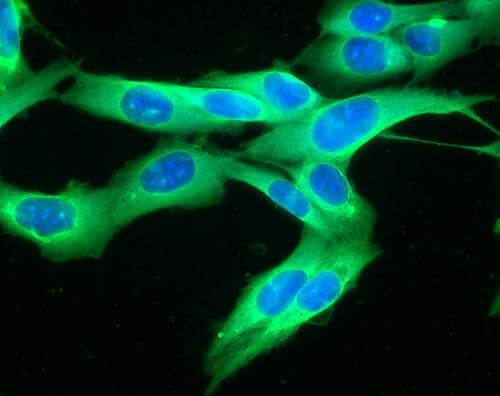Scientists Discover New Melanoma Cell Subpopulation To Blame For Drug-Resistant Tumors
Source: Medical Daily, October 2014

Source: Medical Daily
Just when researchers thought they knew all there was to know about melanoma cells, they have found new characteristics of these cancer cells. A new breed of melanoma cells was recently discovered, and they behave exactly like non-cancerous endothelial cells that populate blood vessels in tumors. Targeting these cells may be another cancer management therapy that scientists think they can exploit.
The discovery of these cells also explains why anti-angiogenic therapies that had been designed to starve tumors by preventing blood vessel formation hadn’t worked. The cells block the drugs and effectively allow the tumors to grow. The research, published in the journal Nature Communications, explains how the cells block drugs developed to destroy blood vessels.
Earlier it was thought that drugs could be used to disintegrate blood vessels by targeting a protein called vascular endothelial growth factor, or VEGF, which is part of a major signaling pathway in the noncancerous endothelial cells that typically line blood vessels in tumors. But lead researcher Andrew C. Dudley and coresearcher James Dunleavey found that a new population of melanoma cells were resistant to a known anti-angiogenic drug, which blocks VEGF. They also found that tumors composed entirely by this new subpopulation in mouse models did not respond at all to anti-VEGF therapy.
Dudley made these discoveries when he isolated what he thought were noncancerous endothelial cells from melanoma tumors. When he conducted genetic analysis on these cells, he found that they did not contain the usual biomarkers like VEGF receptors carried by normal endothelial cells. This is why anti-VEGF therapy could not block tumor growth.
“These cells looked very different from normal endothelial cells in cultures," Dudley explained in a statement. “We didn’t know what these cells were. For a while, we kind of scratched our heads until Jim conducted more experiments over the course of a year to find that these cells had several markers similar to melanoma cells."
Further tests revealed that these were a new type of cancerous cells, which resembled endothelial cells because of the presence of an important protein called PECAM1. PECAM1 is an adhesion molecule and acts like sticky tape to help endothelial cells stick together to form blood vessels. When Dudley’s team looked at blood vessels in tumors made of PECAM1-positive tumors, they found melanoma cells alongside noncancerous endothelial cells on the inside of vessels.
“We don’t think these new melanoma cells are just passively filling in gaps between endothelial cells in the tumor vasculature," Dudley said. “How they come to form blood-filled channels seems to be an active process that involves PECAM1."
On conducting further tests on the vascular density and blood volume of the PECAM1-positive tumor blood vessels, they found that these cells played an important role in the function of tumor blood vessels.
When such cells combine with normal endothelial cells, they are able to circumnavigate anti-VEGF therapies, making them resist drugs. While these cells have been discovered, the researchers say there may be many such pathways by which the tumors are able to resist drugs.
“Anti-angiogenic therapies are typically used in conjunction with another drug," Dunleavey said. “It could be that we’ll need to develop a combination of anti-angiogenic drugs to attack the endothelial cells that form blood vessels and the tumor cells that might form blood-filled channels in tumors."
